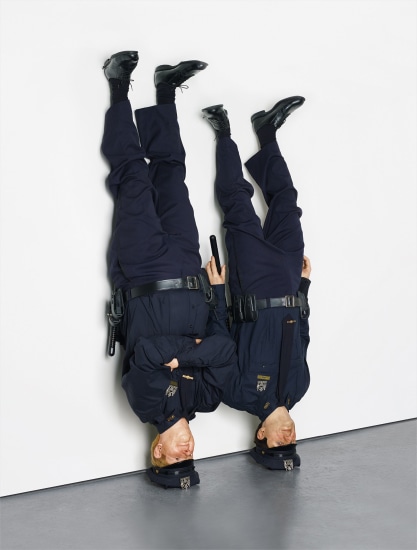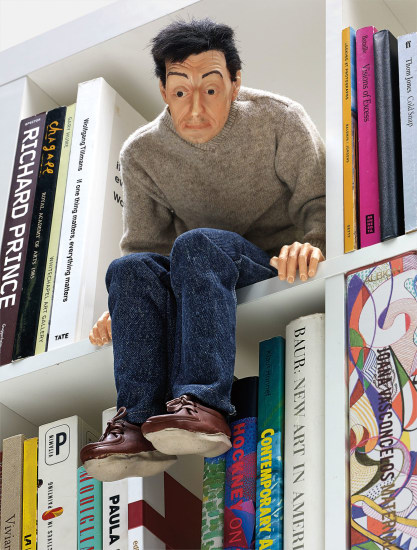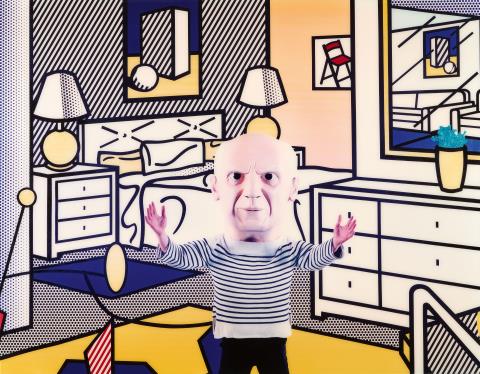Maurizio Cattelan Richard 1996 taxidermied rabbit 17.8 x 7.6 x 7.6 cm (7 x 3 x 3 in.) This work is accompanied by a certificate of authenticity signed by the artist.
Provenance Massimo De Carlo, Milan Catalogue Essay Maurizio Cattelan has a reputation for provocation. Previous works have seen him tape a gallerist to the wall in a posture of mock-crucifixion, dress his Parisian dealer in a phallic rabbit suit, and rent space in a collaborative exhibition to an advertising agency. Challenging the very institutions of which he is part, Cattelan inherits a tradition that dates back to the controversial pranks of Piero Manzoni However, as is so often the case with art world provocateurs, his apparently offhand gestures belie a deeper seriousness. Through postmodern interventions and experimental sculpture, he has weighty points to make. Born in Padua to a working class family, Cattelan spent much of his young life working menial jobs. Looking for a way out of this repetitive existence he turned to art, creating his first piece, a diorama entitled Lessico Familiare, in 1989. Nancy Spector argues that in these early years ‘Cattelan created what can be characterized as an aesthetic of failure – a look, a tone, an attitude that serves to manage expectations, to make excuses before the fact.’ (Nancy Spector, Maurizio Cattelan All, New York, NY: Guggenheim Museum Publications, 2011-12, p.28). His first gallery show comprised an empty room and a sign reading ‘Torno Subito’ (‘Back Soon’). A later exhibition saw him trail a rope of bed sheets out of the gallery window in an iconic evocation of escape. The pieces revealed an anxiety about artistic creation, reflecting on what the artist himself terms ‘the impossibility of doing something.' (Maurizio Cattelan in conversation with Nancy Spector, Maurizio Cattelan London: Phaidon, 2003, p.26) In 1994 Cattelan hosted a show at New York’s Daniel Newburg Gallery; the room was vacant, save for a single chandelier and a grazing donkey. Bathetic in intent, the piece reflected the artist’s unease about his output; as he reflects, ‘my first idea was too expensive. My second idea was not possible to realize. So I saw myself as a donkey.’ (Maurizio Cattelan Galerie Perrotin). In the ensuing years, animals became an increasingly common feature of Cattelan’s work, acting ‘in many cases, as symbols for a certain state of mind, for an emotion in search of physical expression.’ (Nancy Spector, Maurizio Cattelan All, New York, NY: Guggenheim Museum Publications, 2011-12, p.74). Richard dates from 1996: a year which saw Cattelan’s nascent experimentation with taxidermy. In a sense, the creature is the archetypal rabbit in the headlights: a startled animal frozen in a moment of panic. Staring ahead, it seems to look upon some imminent and lethal threat. Yet in the face of this indeterminate menace, it expresses a measure of tenacity; the fixity of its gaze and the rigidity of its posture are equally denotative of resolve as they are of terror. Through Richard, as elsewhere in his taxidermy, Cattelan articulates a rich compound of emotions often understood as distinctively human. In Bidibidobidiboo, another piece of taxidermy from the same year, he makes the anthropomorphism starker. An unnerving tableau, a squirrel sits slumped over a table in a desolate kitchen, a pistol lying at its feet. There is an understandable tendency to distinguish Cattelan’s animals from rest of his oeuvre. Indeed, Cattelan himself perpetuates this paradigm; in his terms the ‘animals are not so funny ... they have a dark, morbid side.’ (Maurizio Cattelan in conversation with Nancy Spector, Maurizio Cattelan London: Phaidon, 2003, p.26-30). Morbidity is undoubtedly a feature of the present lot; macabre connotations are indeed unavoidable when working with taxidermy. However, Richard is by no means entirely distinct from other of his pieces. As Nancy Spector has so convincingly argued, the difficulty of taking action is a recurrent concern in artist's work, evidenced in his bricked-up gallery as in the rope hung from the window. In the countenance of the paralysed yet defiant animal, we witness
Maurizio Cattelan Richard 1996 taxidermied rabbit 17.8 x 7.6 x 7.6 cm (7 x 3 x 3 in.) This work is accompanied by a certificate of authenticity signed by the artist.
Provenance Massimo De Carlo, Milan Catalogue Essay Maurizio Cattelan has a reputation for provocation. Previous works have seen him tape a gallerist to the wall in a posture of mock-crucifixion, dress his Parisian dealer in a phallic rabbit suit, and rent space in a collaborative exhibition to an advertising agency. Challenging the very institutions of which he is part, Cattelan inherits a tradition that dates back to the controversial pranks of Piero Manzoni However, as is so often the case with art world provocateurs, his apparently offhand gestures belie a deeper seriousness. Through postmodern interventions and experimental sculpture, he has weighty points to make. Born in Padua to a working class family, Cattelan spent much of his young life working menial jobs. Looking for a way out of this repetitive existence he turned to art, creating his first piece, a diorama entitled Lessico Familiare, in 1989. Nancy Spector argues that in these early years ‘Cattelan created what can be characterized as an aesthetic of failure – a look, a tone, an attitude that serves to manage expectations, to make excuses before the fact.’ (Nancy Spector, Maurizio Cattelan All, New York, NY: Guggenheim Museum Publications, 2011-12, p.28). His first gallery show comprised an empty room and a sign reading ‘Torno Subito’ (‘Back Soon’). A later exhibition saw him trail a rope of bed sheets out of the gallery window in an iconic evocation of escape. The pieces revealed an anxiety about artistic creation, reflecting on what the artist himself terms ‘the impossibility of doing something.' (Maurizio Cattelan in conversation with Nancy Spector, Maurizio Cattelan London: Phaidon, 2003, p.26) In 1994 Cattelan hosted a show at New York’s Daniel Newburg Gallery; the room was vacant, save for a single chandelier and a grazing donkey. Bathetic in intent, the piece reflected the artist’s unease about his output; as he reflects, ‘my first idea was too expensive. My second idea was not possible to realize. So I saw myself as a donkey.’ (Maurizio Cattelan Galerie Perrotin). In the ensuing years, animals became an increasingly common feature of Cattelan’s work, acting ‘in many cases, as symbols for a certain state of mind, for an emotion in search of physical expression.’ (Nancy Spector, Maurizio Cattelan All, New York, NY: Guggenheim Museum Publications, 2011-12, p.74). Richard dates from 1996: a year which saw Cattelan’s nascent experimentation with taxidermy. In a sense, the creature is the archetypal rabbit in the headlights: a startled animal frozen in a moment of panic. Staring ahead, it seems to look upon some imminent and lethal threat. Yet in the face of this indeterminate menace, it expresses a measure of tenacity; the fixity of its gaze and the rigidity of its posture are equally denotative of resolve as they are of terror. Through Richard, as elsewhere in his taxidermy, Cattelan articulates a rich compound of emotions often understood as distinctively human. In Bidibidobidiboo, another piece of taxidermy from the same year, he makes the anthropomorphism starker. An unnerving tableau, a squirrel sits slumped over a table in a desolate kitchen, a pistol lying at its feet. There is an understandable tendency to distinguish Cattelan’s animals from rest of his oeuvre. Indeed, Cattelan himself perpetuates this paradigm; in his terms the ‘animals are not so funny ... they have a dark, morbid side.’ (Maurizio Cattelan in conversation with Nancy Spector, Maurizio Cattelan London: Phaidon, 2003, p.26-30). Morbidity is undoubtedly a feature of the present lot; macabre connotations are indeed unavoidable when working with taxidermy. However, Richard is by no means entirely distinct from other of his pieces. As Nancy Spector has so convincingly argued, the difficulty of taking action is a recurrent concern in artist's work, evidenced in his bricked-up gallery as in the rope hung from the window. In the countenance of the paralysed yet defiant animal, we witness









Try LotSearch and its premium features for 7 days - without any costs!
Be notified automatically about new items in upcoming auctions.
Create an alert